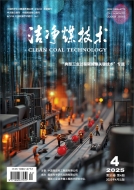In order to clarify the causes and caking characteristics of steel rolling oil sludge in the rotary kiln, an evaluation method of ring formation characteristics in the rotary kiln of oxidation pellets was used to study the cohering behavior of steel rolling oil sludge under different working conditions.The physical composition and morphology of the crystalline ring products were characterized and tested by ash melting point, powder X-ray fluorescence spectroscopy XRF, powder X-ray diffraction spectroscopy (XRD), bulk scanning electron microscopy (SEM) and energy spectrum analyzer (EDS). The effects of roasting temperature and roasting time on the cohering properties of the rolled oil steel sludge on the refractory brick surface were investigated by using ring index and adhesion index as evaluation indexes. The results show that the ringing index and adhesion index of steel rolling oil sludge increase with the increase of roasting time and roasting temperature.The fastest growth rate is in the range of 1 150 ℃ to 1 250 ℃, which coincides with the dense distribution of the main ringing materials in the kiln, indirectly confirming the applicability of the method for evaluating the ringing behavior. The characterization results show that the mineral phase of the crystalline material has coarse grains, the uneven structure, more voids, the obvious distribution of individual grain crystals and the fused surface, and the low degree of crystallization of the whole.The ring-forming process of steel rolling oil sludge rotary kiln are mainly due to the solid-phase solidification reaction of Fe2O3, and the remaining small amount of impurities generate low melting point substances, which to a certain extent promote the migration of iron grains and intensify the ring-forming behavior.That is consistent with the XRD detection that the physical phase of the rings is mainly hematite, followed by iron oxides such as magnetite and low melting point substances.The deformation temperature and softening temperature of the rings in the gray melting point test are generally increasing, which further proves that the recrystallization of secondary Fe2O3 and generated Fe3O4 in the oxidizing environment makes the rings stronger and less fragile,thus causing the evolution of the ring to deteriorate.
Simulation of incineration bonding behavior and characterization of ringings in coal-fired rotary kiln for steel rolling oil sludge
 2022 No. 10
2022 No. 10
 1018
1018 446
446

Authors:
- XIE Bin
- YANG Jianping
- LENG Lijian
- LI Hailong

Unit:
- School of Energy Science and Engineering,Central South University

Abstract:

Keywords:
- steel rolling oil sludge
- rotary kiln
- ring-forming characteristics
- formation mechanism
- low melting point substances

Citation format:
谢斌(1998—),男,四川巴中人,硕士研究生。E-mail:1162360838@qq.com

Chart:

Articles:
--

Citation format:
--

-
Executive director
China Coal Science and Industry Group Co., Ltd
-
Sponsored by
Coal Science Research Institute Co., Ltd
Coal Industry Clean Coal Engineering
Technology Research Center -
Editor in Chief
XIE Qiang
-
Vice Editor-in-Chief
YU Chang
SHI Yixiang
ZHAO Yongchun
DUAN Linbo
CAO Jingpei
ZENG Jie -
Publication Frequencies
Monthly
-
ISSN
1006-6772
-
CN
11-3676/TD
Covered by
- CSTPCD
- RCCSE(A+)
- AJ
- EBSCO host
- Ulrichsweb
- JST
- Scopus
Contact us
New Media
-
 Meichuanmei
Meichuanmei -
 Clean Coal Technology
Clean Coal Technology -
 Online Journals
Online Journals








 Submission system
Submission system Copyright agreement
Copyright agreement Instructions for authors
Instructions for authors